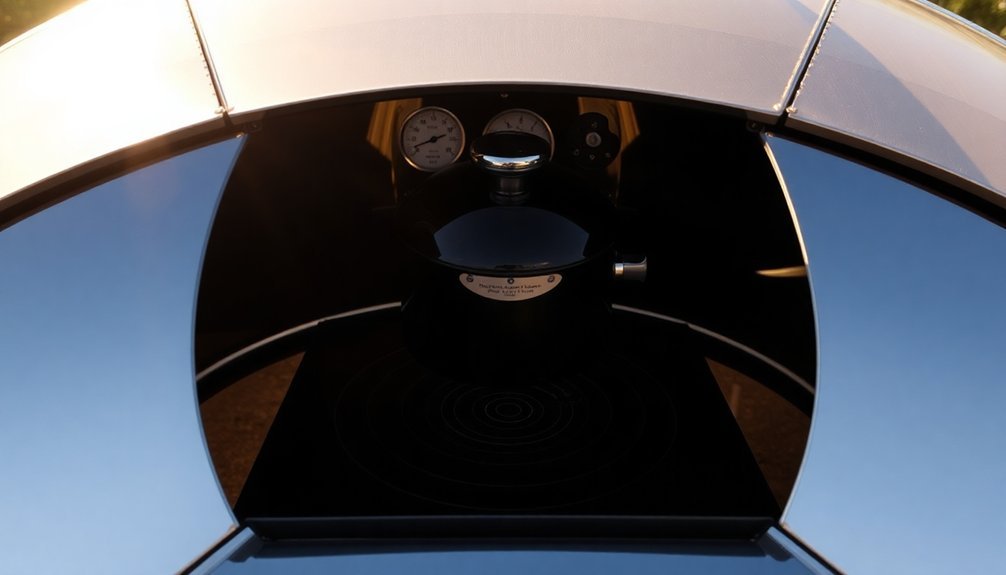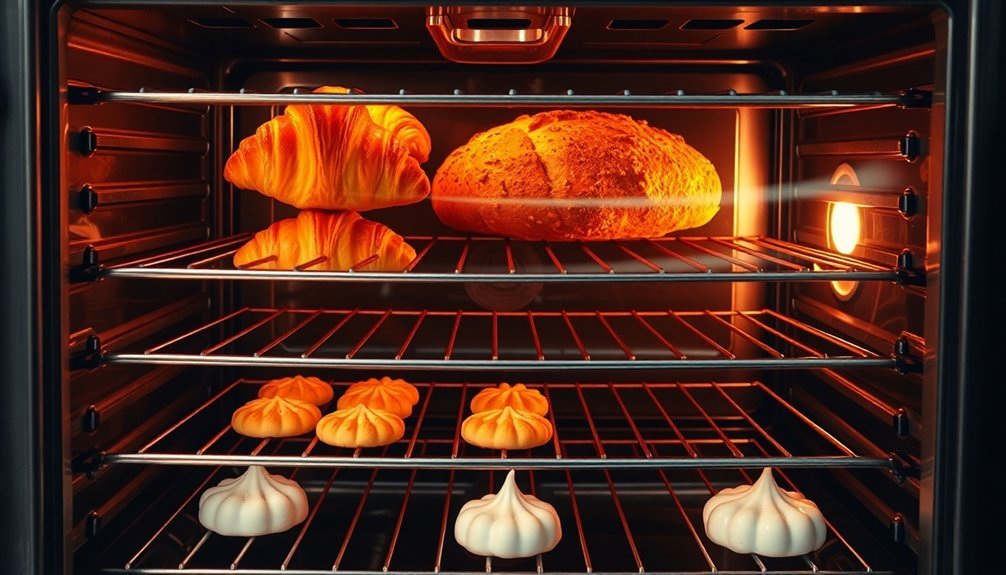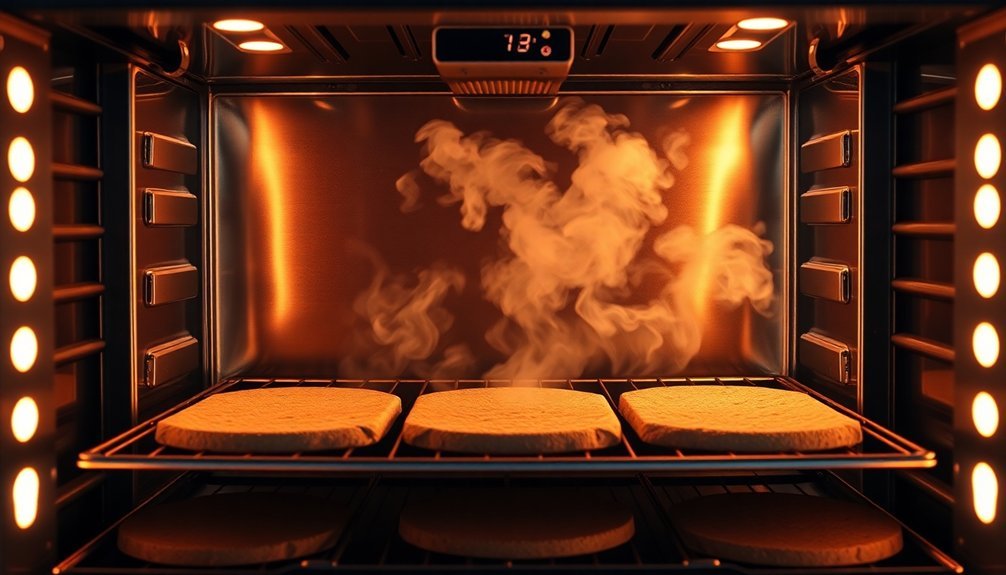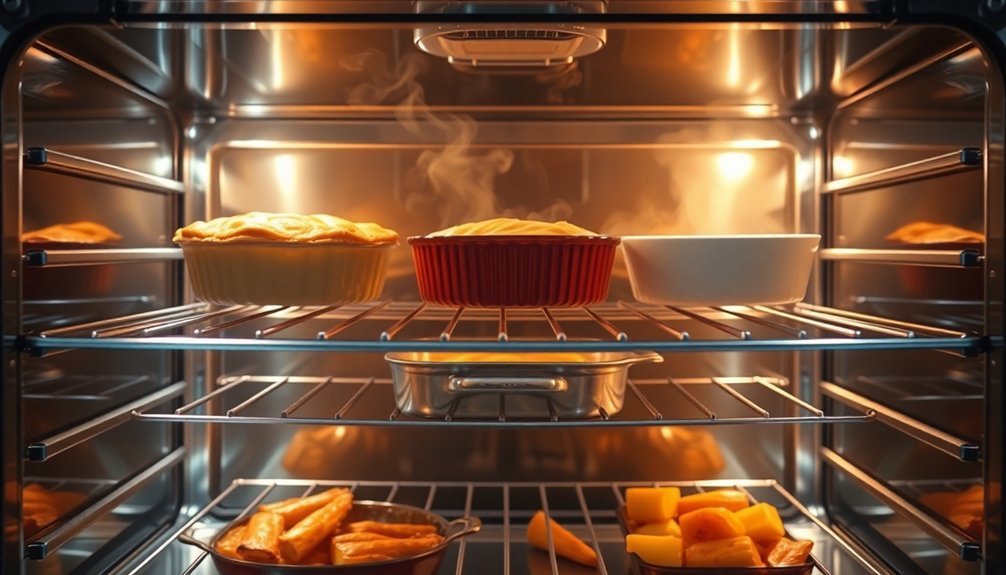To maximize your oven's efficiency through zone heating, you'll want to position your oven correctly between 11 AM and 3 PM for ideal sunlight exposure. Set up your reflector panels at angles between 60 and 120 degrees, adjusting them every 20-30 minutes to track the sun. Implement a dual-zone system with independent convection fans for up to 30% greater efficiency. Choose dark cookware for stronger heat radiation and better browning, but remember to reduce temperatures by 25°F. Use thick-bottomed ceramic or glass bakeware and silicone mats to enhance heat retention. These fundamental techniques just scratch the surface of mastering zone-heating efficiency.
Positioning Your Solar Oven Correctly

Four key factors determine successful solar oven positioning: timing, angle, environment, and stability.
You'll get the best results by positioning your solar oven between 11:00 AM and 3:00 PM when sunlight is strongest. Adjust the position every 20-30 minutes to follow the sun's path, and start earlier (around 10:00 AM) during winter months. Performance can significantly decline when exposed to winds over 30 mph.
Orient the shorter front panel eastward for noon meals or westward for evening cooking, and set the oven's angle equal to your location's latitude.
Choose a sunny, sheltered spot with minimal cloud cover and place your oven on dry, level ground. For stability in windy conditions, secure the sides with large stones or bricks.
Create an air gap under the pot using a wire rack, and use clothespins to secure the front panel's flaps.
Reflector Panel Setup Techniques
Proper reflector panel setup plays an essential role in maximizing your solar oven's efficiency.
You'll want to position your reflectors at ideal angles – no more than 22.5 degrees from perpendicular to the glass, or 20 degrees for taller reflectors. The optimal angle range of 60 to 120 degrees will provide efficient heat reflection to your cooking area.
For effective zone heating, adjust your top reflector to a steep angle and bottom reflector to a shallow angle, especially during low sun positions.
- Use a protractor to measure and fine-tune reflector angles until sunlight hits the opposite side of your target area
- Choose durable materials like aluminum foil tape or aluminum-covered foam boards for your reflectors
- Install panels securely but removable to allow for easy adjustments as sun position changes
Temperature Zone Management

Strategic temperature zone management forms the foundation of efficient oven operation.
You'll achieve up to 30% greater fuel efficiency by implementing dual-zone impingement systems that independently control convective heat flux through your pans and products.
You can divide your oven into 7- to 28-ft zones, each equipped with its own convection and exhaust fans.
Through touchscreen interfaces, you'll maintain precise control over temperature, humidity, and steam settings in each zone.
Set up your center-fed chevron burners with variable-speed top and bottom forced convection systems to guarantee balanced lateral heat distribution.
To optimize performance, use servo motors to control air valves and regulate airflow between zones.
Store your settings as "recipes" for consistent startups, and implement gap control to automatically adjust heat distribution based on product flow.
Utilizing high-radiant steel ceilings in your oven design will enhance uniform baking through superior heat storage and redistribution capabilities.
Dark Cookware Selection Tips
Dark cookware's unique properties greatly influence heat absorption and cooking outcomes in your oven. When selecting dark pans, you'll need to take into account their enhanced heat absorption capabilities and adjust your cooking approach accordingly. Dark cookware radiates stronger heat from all surfaces during baking.
They're perfect for dishes requiring crispy textures or deep browning, but you'll want to reduce temperatures by 25°F when using recipes designed for light-colored pans.
- Perfect for pizzas, roasted vegetables, and cornbread where browning and crispiness are desirable
- Not ideal for delicate baked goods like cakes and cookies, unless you adjust temperature and timing
- Requires specific maintenance, including seasoning for cast iron and careful cleaning to prevent rust
Remember to check your food 10-15 minutes earlier than usual when using dark cookware, as it can accelerate cooking times considerably.
For best results, rotate pans during cooking to guarantee even heat distribution.
Heat Retention Methods

Mastering heat retention in your oven can considerably reduce energy costs while improving cooking results.
You'll maximize efficiency by selecting thick-bottomed ceramic or glass bakeware, which holds heat better than metal alternatives. Using silicone baking mats further enhances heat retention while reducing cooking times.
Make the most of residual heat by turning off your oven a few minutes before food is fully cooked – it'll continue cooking with the stored warmth.
Keep the door closed and use the oven light to check progress instead of opening it repeatedly. When possible, cook multiple dishes simultaneously and plan your meals to take advantage of the retained heat.
For ideal results, confirm you're using proper temperature settings with an oven thermometer, and don't forget to thaw ingredients beforehand to reduce overall cooking time.
Frequently Asked Questions
Can Zone Heating Damage My Oven's Internal Components Over Time?
Yes, if you're not careful, zone heating can damage your heating elements, sensors, and insulation. You'll need to monitor hot spots, check components regularly, and guarantee proper heat distribution to prevent long-term damage.
How Do Weather Conditions Affect Solar Oven Zone Heating Performance?
Your solar oven's zone heating effectiveness depends heavily on weather conditions. You'll notice reduced performance during cloud cover, while wind can disrupt heat zones. Season and ambient temperature also impact your heating zones' stability.
What Safety Precautions Should I Take When Adjusting Oven Zone Temperatures?
Always wear heat-resistant gloves when adjusting zones, monitor temperature readings carefully, and don't open doors suddenly. You'll need to maintain proper ventilation and keep flammable materials away from the oven during adjustments.
Are Certain Foods Better Suited for Specific Heating Zones?
Yes, you'll want to use the top zone for thin foods and browning, the middle zone for baking and casseroles, and the bottom zone for crusty breads and pizzas for best results.
How Long Should I Pre-Heat Different Zones Before Cooking Begins?
You'll want to pre-heat kitchen zones 15-20 minutes before cooking starts. Set your thermostat 2-3 degrees higher in cooking areas, and maintain adjacent zones at normal temperatures for ideal airflow and efficiency.
In Summary
You'll get the most out of your solar oven by combining these five zone-heating methods. Position your oven ideally, adjust your reflector panels precisely, manage temperature zones carefully, use dark cookware strategically, and implement proper heat retention techniques. When you've mastered these approaches, you'll greatly boost your oven's efficiency and enjoy better cooking results while maximizing your solar energy use.





Leave a Reply